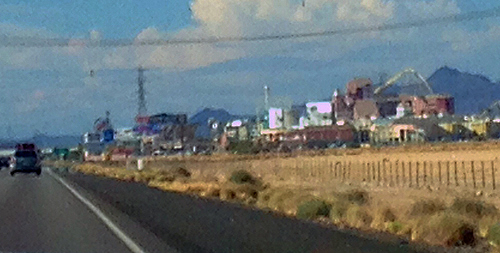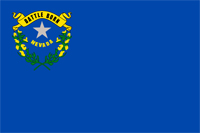
–Seventh in a series–
By Donald H. Harrison


PRIMM, Nevada – As grandson Shor and I drove through the California desert, we saw shimmering in front of us what seemed a scene out of Oz, or maybe Xanadu: some tall structures including a giant roller coaster. Was this one of those fabled desert mirages often read about in adventure stories?
No, in reality it was a group of hotel casinos with names like “Buffalo Bill’s” and “Whiskey Pete’s” hugging the Nevada side of the California-Nevada state line and capitalizing upon the fact that gambling of all varieties is legal throughout Nevada, whereas in California the venues for engaging lady luck are, for the most part, restricted to Indian reservations.
As we drew closer to the vision in the distance, I couldn’t help but reflect how important were borders—these artificial lines on a map separating one state or country from another—in the history of our Jewish people.
During the Nazi scourge of World War II, crossing a border could mean the difference between life and death. If from Austria you could pass over the Alps, then Switzerland’s neutrality might protect you from deportation to the Nazi death camps. The same was true of neutral Sweden, which was a haven for the Jews of Denmark. Elsewhere in Europe, Jews who made it from Poland to Russia and then on to China could find safe haven in Shanghai. But such escape routes were the exceptions; most of the Jews of Europe were annihilated during the Nazi madness.
Today, the borders most important to Jewish survival are those in the Middle East. They were drawn after World War I by the victorious Western powers that defeated the Ottoman Turks. Subsequently, they were modified by a partition vote of the United Nations General Assembly, and redrawn again after wars broke out in 1948, 1967, and 1973, between Israel and its Arab neighbors. More modifications came as a result of peace treaties between Israel and Egypt, and Israel and Jordan, and also following Israel’s agreement to create dependent Palestinian territories in Judea and Samaria, and its unilateral decision to withdraw Israeli towns and settlements from all of Gaza.
Currently borders marking Israel’s boundaries are in violent dispute. Some say Israel should continue to hold all the territory currently in its possession. Others, favoring the “two-state solution” want a new nation of Palestine to be carved out of the territory that Israel won after it was attacked in 1967 by Egypt, Syria and Jordan. Some want Israel to keep the high land of the Golan that it won from Syria in that war; others want Israel to someday return it. And then there are those who not only want Israel to give up the land it won in self-defense in 1967, but also the land which has enabled it to be a sovereign nation. Radical Arabs, along with some supporters in the West, want all the Jews expelled from their historic biblical homeland, once and for all, to go to who cares where.
As our car crossed into Nevada, with the neon lights of late afternoon twinkling a welcome, I couldn’t help but reflect that the 50 states of the United States of America are all part of one generally harmonious country, which allows for local differences among the states such as determining whether gambling shall be legal or illegal, and determining at what age one might legally drive a car or consume alcohol.
However miniscule these differences are compared to the importance of borders elsewhere, they can be a major source of economic stimulation Landlocked Nevada benefits from gambling-loving tourists who flock to its borders not only from California but also from Oregon, Idaho, Utah, and Arizona. How lucky we are in the United States that we cross borders not to flee from something but because something else attracts us!
In the greater context of border crossing, it was easy to minimize, on reflection, what Shor and I perceived as the shortcomings of Buffalo Bill’s as a place to stay. We had to drag our luggage through a smoky casino to get to the check-in desk, and there were 26 people in the line with only two attendants at the registration desk, along with a supervisor whose arms were folded across her chest. It took an intolerably long time to be served.
When we finally got to our room, which seemed comfortable enough at first glance, we were disappointed to learn that the telephone service did not work either for incoming nor outgoing calls. Exhausted, we decided to rely on our cell phones rather than to go through the process of requesting a room change. Then we noticed and tried to ignore for the rest of the night the fact that the water in the toilet would not stop running, no matter how often you jiggled the handle or lifted the ball within the tank.
These were trivial matters, as one reflected on how fortunate we are to live and travel in peacetime America. Besides that, we comforted ourselves with the thought that the next day, northbound Interstate 15 would take us to Las Vegas, Nevada, where hotels generally are maintained at a far higher standard.
*
Harrison is editor of San Diego Jewish World. He may be contacted via donald.harrison@sdjewishworld.com
Great article… I remember staying in Primm a couple times when our boys were little while travelling to see my parents in Escondido. Back then there were two places only, but the ferris wheel was a treat for the boys.
Your commentary on the borders really struck a note in my heart. We are truly blessed to live in these United States.
Travel safely, Don and Shor! Shabbat Shalom!